View as PDF
View this email on our site
Subscribe to this newsletter
Dawn H. Gouge1, Shujuan (Lucy) Li1, Christopher Bibbs2, Shaku Nair1
1Department of Entomology, University of Arizona
2Salt Lake City Mosquito Abatement District
As the temperature rises, so does the scorpion activity around our homes and buildings. Scorpions are predatory arachnids related to spiders, mites, and ticks. They are some of the oldest known terrestrial arthropods, which are animals with an external skeleton, a segmented body, and paired jointed limbs. Scorpions have an elongated body and a segmented tail that ends in a stinger which can deliver a venomous sting (Figure 1). They have four pairs of legs and pedipalps with plier-like pincers on the end, used for grasping (Figure 1).

Figure 1. Left: Arizona bark scorpion eating a cricket. Credit: Melissa Sikes. Right: Scorpion pedipalps.
There are about 2,000 described species of scorpions worldwide, with >100 in the United States and over 50 species in the desert southwestern states. Scorpions have long been of concern and interest to humans primarily due to their ability to give painful, and sometimes life-threatening stings, but also because they are important and beneficial components of many ecosystems.
SCORPION BIOLOGYMany species of scorpion can survive without food or water for several months, especially during the cooler seasons. Most scorpions are nocturnal or active at night. They are excellent predators and can detect prey when it comes within reach. The desert hairy scorpion readily consumes the smaller scorpion species!
Scorpions can be found during the daytime in harborage areas where it is cool and moist, such as places under rocks, inside walls, wood, tree bark, vegetation, or in burrows. They may be abundant in rocky terrain, natural or artificial wash areas, in and on hollow-block walls or around artificial landscaping with plenty of boulders and rocks. Populations are usually higher where water and prey is abundant. In the desert, this means historic washes, present-day rerouted washes, and irrigated landscapes.
Generally, a female gives birth to about 25-35 young. Newborn scorpions promptly climb on the mother’s back and remain there until their first molt (Figure 2). The pale colored young have been seen to climb down off the mother’s back, molt then return to the mother’s back for several days before leaving for good, usually within one to three weeks after birth. Once they assume an independent existence, they periodically molt to reach adulthood. Typically, five or six molts over two to six years are required for the scorpion to reach maturity. The average scorpion lifespan is 3-5 years. However, some larger species may live upwards of 12 years!
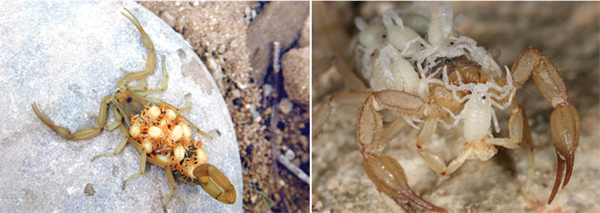
Figure 2. Left: Female bark scorpion with young on her back. Right: Female striped-tail scorpion with young. Credit: Dawn H. Gouge.
The Arizona bark scorpion, Centruroides sculpturatus, is the most commonly occurring scorpion in the low desert southwest, and also the most venomous scorpion in the United States (Figure 3). This species also colonizes small parts of California, Nevada, New Mexico, Utah, Colorado, Texas, and northwestern Mexico.

Figure 3. Arizona bark scorpion hiding on a conifer cone. Credit: Chloe Fung.
Bark scorpions are the only social scorpion found in urban areas (Figure 4). They may be found in large numbers – notably in hollow-block walls commonly used to border homes and schools. They easily access the interior of the hollow blocks through narrow cracks and crevices. The blocks provide protection from extreme temperatures and may hold water after a rain event.
As a general retreat response, bark scorpions seek out dark places they can squeeze into. This includes a great variety of natural and man-made places, especially where prey is abundant, such as under tree bark, rocks, potted plants, patio debris, door mats, and narrow cracks in wood or cement. If you leave wet towels around the pool overnight, scorpions may be attracted to the moisture in the towels and crawl inside.
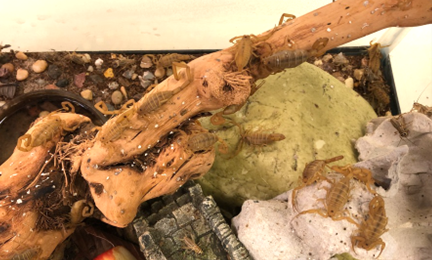
Figure 4. Bark scorpions cohabit and they can cluster together in groups. Credit: Shujuan Li.
Young children (smaller than 70lb in weight), the elderly, and hypertensive people are the most adversely affected by the scorpion venom, and may require antivenin. All scorpions possess venom and can sting, but their natural tendency is to escape and hide.
If you suspect a bark scorpion sting call 911 if a child in involved, or Poison Control (state-wide): 1-800-222-1222.
The giant desert hairy scorpion, Hadrurus arizonensis (Figure 5) is the largest scorpion in the U.S. They are heavy bodied scorpions, and adults often exceed 5 inches in length. This species can be found in the Sonoran and Mojave Desert areas of Arizona, California, Nevada and Utah, as well as the Sonoran and Baja California Norte areas of Mexico. They have a mild venom, but strong pedipalps that they use to grasp prey. The scorpions often have a darker body, pale sides, and pale buff colored appendages, when viewed from above. They feed on a wide variety of insects, arachnids, small lizards and other animals. This species is also called the Arizona desert hairy scorpion as they are found in low sandy areas. The harmless giants spend most of their time under rocks and in shallow burrows. They are a beneficial addition to your home landscape as they consume Arizona bark scorpions voraciously.

Figure 5. The giant desert hairy scorpion. Credit: Robb Hannawacker.
The Arizona stripe-tailed scorpion, Paravaejovis spinigerus (Figure 6), and the yellow ground scorpion, Vaejovis confusus (Figure 7) are burrowing species, and full-grown at less than 3 inches in length.
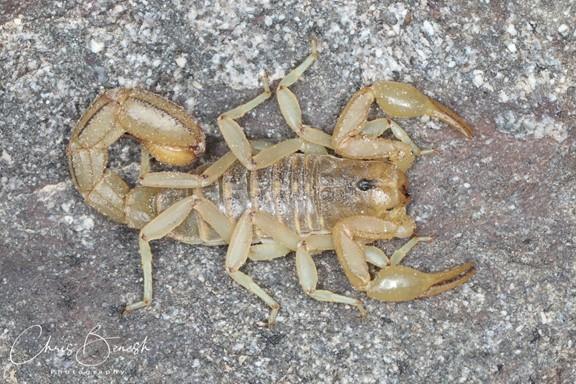
Figure 6. Arizona stripe-tailed scorpion. Credit: Chris Benesh.

Figure 7. Yellow ground scorpion. Credit: Ernie Cooper.
These two scorpions are often mistaken for bark scorpions. The Arizona stripe-tailed scorpion is heavily armored, with comparatively bulkier pedipalps and tail (Figure 6). Although yellow ground scorpions have more delicate pedipalps, their tails are wider and much bulkier (Figure 7). Both scorpions feed on smaller arthropods, and seek moisture.
The Arizona stripe-tailed scorpion is found in Arizona, California, southwestern New Mexico and northwestern Sonora in Mexico, while the less commonly found, but broadly present yellow ground scorpion is reported throughout much of Arizona, California, Idaho, Nevada, Utah and northern Mexico.
Both scorpions are typically found on sandy soils in a variety of habitat, from desert floor to rocky hillsides, and under many surface objects, including sleeping bags, shoes, etc. where it digs a short burrow or “scrape” for protection. The scorpions sting, but their venom is relatively mild, and does not usually require medical intervention.
IPM METHODS FOR SCORPIONSGenerally, scorpions are fascinating desert creatures and beneficial for the control of insect pests, including cockroaches and crickets. But bark scorpions themselves can become a serious pest around schools, homes, and childcare buildings if they are entering the buildings. Scorpions are impossible to manage with insecticides alone. Chemical pesticide spraying is not generally effective. Effective management strategies include pest-proofing buildings and habitat modification surrounding a house or structure.
To manage scorpions, try the following:

Figure 8. Arizona bark scorpions glow under a black light (ultraviolet light). Credit: Shujuan Li.
For more information, read Scorpions of the Desert Southwest United States: https://extension.arizona.edu/sites/extension.arizona.edu/files/pubs/az1768-2018.pdf
For more information, watch Arizona Scorpions. https://youtu.be/VSCvHtep86E. This video covers the scorpions commonly found in Arizona, their biology and behavior. It also demonstrates how to inspect for scorpions using a UV light at night. The take-home-message is that scorpions are beneficial predators and an interesting feature of the Desert Southwest.
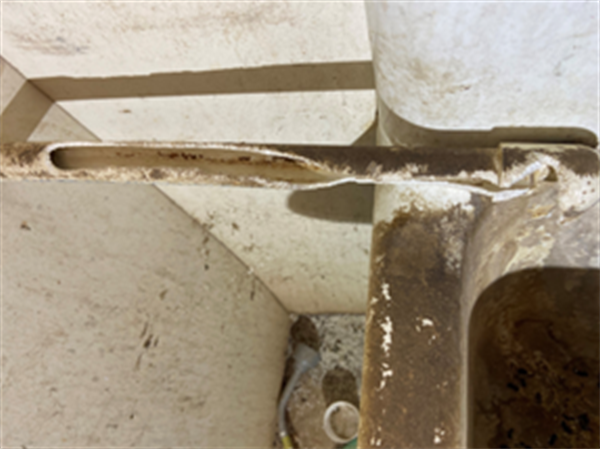
Answer: Roof rats (Rattus rattus) nibbled away through this pipe to access water. Roof rats usually nest close to reliable water sources. They are attracted to both food and water since they need to drink every day. So, if you are trying to discourage them, pick up fallen fruit from trees, keep external trash cans closed, and limit outdoor sources of water including birdbaths, pet dishes, and leaking irrigation emitters.
Congratulations to Master Pest Detective Landon Phillips, IPM Coordinator,
Clear Creek ISD, who instantly sent the correct answer
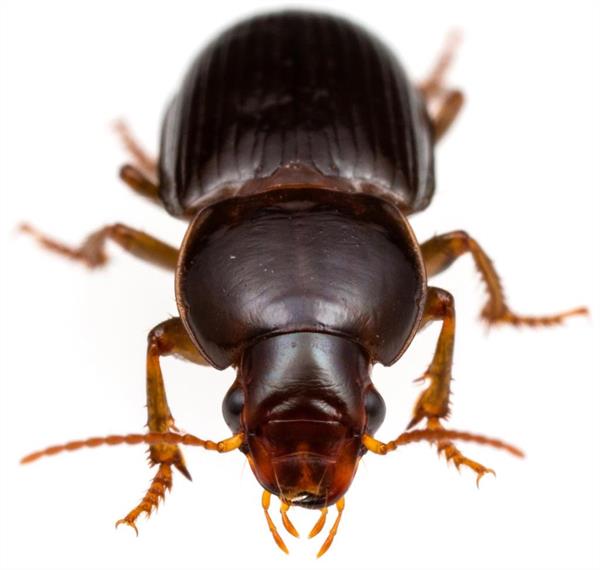
If you know what this is, email the answer to Dawn at
dhgouge@email.arizona.edu. You will not win anything if you are correct, but
you will be listed as a “Master ID Detective” in the next newsletter issue.
Pest management professionals can jumpstart their careers through the Certified Integrated Pest Management (IPM) Technician credential from the Entomological Society of America Certification Corp. https://entocert.org/cit
Designed for professionals with less than five years’ experience in pest management, the Certified IPM Technician (CIT) credential demonstrates a foundational skillset and commitment to the IPM principles and practices. Applications for the credential are now being accepted by the ESA Certification.
ESA also offers several other certification programs for professionals:
What’s Bugging You? First Friday Events (New York State IPM Program)
Fridays | 12:00 pm. – 12:30 p.m. EDT | Zoom | Free; registration required
The first Friday of each month, spend half an hour over lunch learning about practical solutions for pest problems with the New York State IPM Program. Each presentation will end with an IPM Minute. https://nysipm.cornell.edu/whats-bugging-you/first-friday-events/
Upcoming First Friday Events:
National Park Service IPM Webinar Series
Horticultural Research Institute (tHRIVe) web series.
Free and open to the public, registration required. Times listed are Eastern Time.
https://www.hriresearch.org/thrive-web-series
UMass Extension’s Green School
October 25, 2022 – December 15, 2022 | 3 hours (plus break) on Tuesday, Wednesday, and Thursday afternoons | $900 early bird, $1,025 regular, scholarships available
https://ag.umass.edu/landscape/education/umass-extensions-green-school
A comprehensive 60-plus-hour-certificate short course that offers fundamental horticultural training in a compact time frame. The program is designed for professional practitioners such as landscapers, lawn care providers, nursery operators, sports field managers, public and private grounds managers, arborists, professional gardeners, landscape and garden designers, and others in the green industries. Both experienced professionals and those aspiring to be will benefit from this course.
Registration deadline October 18. For early-bird tuition rate, register by September 15.
EPA Webinars about Integrated Pest Management
The EPA Center of Integrated Pest Management hosts a webinar series featuring national experts from across the country relaying educational and practical strategies for establishing and improving integrated pest management programs in buildings. We invite you to review the information on the past topics. Register for new or review archived IPM webinars https://www.epa.gov/ipm/previous-webinars-about-integrated-pest-management
To view all our previous newsletters, visit: https://acis.cals.arizona.edu/community-ipm/home-and-school-ipm-newsletters
This material is in part funded by the National Institute of Food and Agriculture, U.S. Department of Agriculture, under award number 2021-70006-35385 that provides Extension IPM funding to the University of Arizona. It is funded in part by the USDA National Institute of Food and Agriculture through the Western Integrated Pest Management Center, grant number 2018-70006-28881. Additional support is provided by the UA Arizona Pest Management Center and Department of Entomology. Any opinions, findings, conclusions, or recommendations expressed in this publication are those of the authors and do not necessarily reflect the views of the U.S. Department of Agriculture or those of other funders.